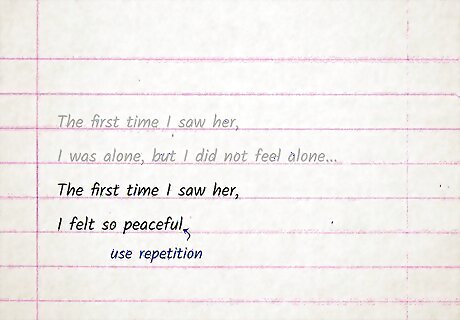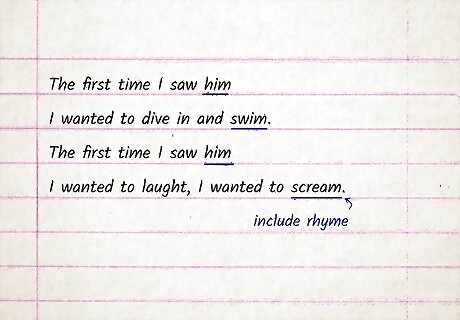
views
Picking the Topic of Your Piece

Choose a topic that triggers a strong feeling or opinion. Maybe you go for a topic that makes you angry, like war, poverty, or loss, or excited, like love, desire, or friendship. Think of a topic that you feel you can explore in depth with passion. You may also take a topic that feels broad or general and focus on a particular opinion or perspective you have on it. For example, you may look at a topic like “love” and focus on your love for your big sister. Or you may look at a topic like “family” and focus on how you made your own family with close friends and mentors.

Focus a memorable moment or experience in your life. Pick an experience that was life changing or shifted your perspective on the world in a profound way. The moment or experience could be recent or from childhood. It could be a small moment that became meaningful later or an experience that you are still recovering from. For example, you may choose to write about the moment you realized you loved your partner or the moment you met your best friend. You can also write about a childhood experience in a new place or an experience you shared with your mother or father.

Respond to a troubling question or idea. Some of the best spoken word comes from a response to a question or idea that makes you think. Pick a question that makes you feel unsettled or curious. Then, write a detailed response to create the spoken word piece. For example, you may try responding to a question like “What are you afraid of?” “What bothers you about the world?” or “Who do you value the most in your life?”

Watch videos of spoken word pieces for inspiration. Look up videos of spoken word poets who tackle interesting subjects from a unique point of view. Pay attention to how the performer tells their truth to engage the audience. You may watch spoken word pieces like: “The Type” by Sarah Kay. “When a Boy Tells You He Loves You” by Edwin Bodney. “Lost Voices” by Darius Simpson and Scout Bostley. “The Drug Dealer’s Daughter” by Sierra Freeman.
Composing the Spoken Word Piece

Come up with a gateway line. The gateway line is usually the first line of the piece. It should sum up the main topic or theme. The line can also introduce the story you are about to tell in a clear, eloquent way. A good way to find a gateway line is to write down the first ideas or thoughts that pop into your head when you focus on a topic, moment, or experience. For example, you may come up with a gateway line like, “The first time I saw her, I was alone, but I did not feel alone.” This will then let the reader know you are going to be talking about a female person, a “her,” and about how she made you feel less lonely.

Use repetition to reinforce an idea or image. Most spoken word will use repetition to great effect, where you repeat a phrase or word several times in the piece. You may try repeating the gateway line several times to remind the reader of the theme of your piece. Or you may repeat an image you like in the piece so the listener is reminded of it again and again. For example, you may repeat the phrase “The first time I saw her” in the piece and then add on different endings or details to the phrase.

Include rhyme to add flow and rhythm to the piece. Rhyme is another popular device used in spoken word to help the piece flow better and sound more pleasing to listeners. You may follow a rhyme scheme where you rhyme every other sentence or every third sentence in the piece. You can also repeat a phrase that rhymes to give the piece a nice flow. For example, you may use a phrase like "Bad dad" or "Sad dad" to add rhyme. Or you may try rhyming every second sentence with the gateway line, such as rhyming "The first time I saw him" with "I wanted to dive in and swim." Avoid using rhyme too often in the piece, as this can make it sound too much like a nursery rhyme. Instead only use rhyme when you feel it will add an extra layer of meaning or flow to the piece.

Focus on sensory details and description. Think about how settings, objects, and people smell, sound, look, taste, and feel. Describe the topic of your piece using your 5 senses so the reader can become immersed in your story. For example, you may describe the smell of someone’s hair as "light and floral" or the color of someone’s outfit as "as red as blood." You can also describe a setting through what it sounded like, such as "the walls vibrated with bass and shouting," or an object through what it tasted like, such as "her mouth tasted like fresh cherries in summer."

End with a strong image. Wrap up the piece with an image that connects to the topic or experience in your piece. Maybe you end with a hopeful image or with an image that speaks to your feelings of pain or isolation. For example, you may describe losing your best friend at school, leaving the listener with the image of your pain and loss.

Conclude by repeating the gateway line. You can also end by repeating the gateway line once more, calling back to the beginning of the piece. Try adding a slight twist or change to the line so the meaning of it is deepened or changed. For example, you may take an original gateway line like, “The first time I saw her” and change it to “The last time I saw her” to end the poem with a twist.
Polishing the Piece

Read the piece aloud. Once you have finished a draft of the spoken word piece, read it aloud several times. Pay attention to how it flows and whether it has a certain rhythm or style. Use a pen or pencil to underline or highlight any lines that sound awkward or unclear so you can revise them later.

Show the piece to others. Get friends, family members, or mentors to read the piece and give you feedback. Ask them if they feel the piece feels like it represents your style and attitude. Have others point out any lines or phrases they find wordy or unclear so you can adjust them.

Revise the piece for flow, rhythm, and style. Check that the piece has a clear flow and rhythm. Simplify lines or phrases to reflect how you express yourself in casual conversation or among friends. You should also remove any jargon that feels too academic or complex, as you do not want to alienate your listener. Instead, use language that you feel comfortable with and know well so you can show off your style and attitude in the piece. You may need to revise the piece several times to find the right flow and meaning. Be patient and edit as much as you need until the piece feels finished.
Doing a Spoken Word Performance

Memorize the piece. Read the piece aloud several times. Then, try to repeat it aloud without looking at the written words, working line by line or section by section. It may take several days for you to memorize the piece in its entirety so be patient and take your time. You may find it helpful to ask a friend or family member to test you when you have memorized the piece to ensure you can repeat every word by heart.

Use your voice to convey emotion and meaning to the audience. Project your voice when you perform. Make sure you enunciate words or phrases that are important in the piece. You can also raise or lower your voice using a consistent pattern or rhythm when you perform. Try speaking in different registers to give the piece variety and flow. A good rule of thumb is to say the gateway line or a key phrase louder than other words every time you repeat it. This can help you find a sense of rhythm and flow.

Express yourself with eye contact and facial gestures. Maintain eye contact with the audience when you perform the poem, rather than looking down or at a piece of paper. Use your mouth and face to communicate any emotions or thoughts expressed in the poem. Make facial gestures like a look of surprise when you describe a realization, or a look of anger when you talk about an injustice or troubling moment. You can also use your hands to help you express yourself. Make hand gestures to the audience to keep them engaged. Keep in mind the audience will not really be paying attention your lower body or your legs, so you have to rely on your face, arms, and upper body in your performance.

Practice in front of a mirror until you feel confident. Use a mirror to get a sense of your facial expressions and your hand gestures. Maintain eye contact in the mirror and project your voice so you appear confident to the audience. Once you feel comfortable performing to the mirror, you may decide to perform for friends or family. You can also perform the spoken word piece at a poetry slam or an open mic night once you feel it is ready to share with others.

















Comments
0 comment